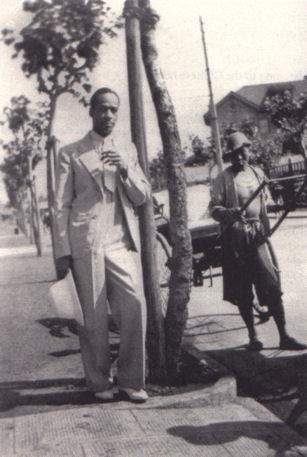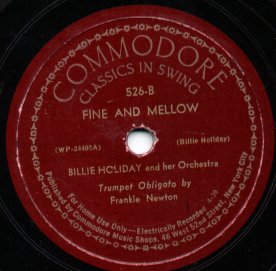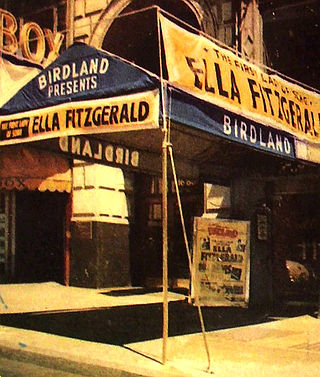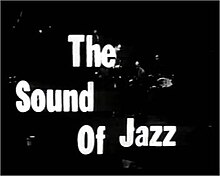
Harry "Sweets" Edison was an American jazz trumpeter and a member of the Count Basie Orchestra. His most important contribution was as a Hollywood studio musician, whose muted trumpet can be heard backing singers, most notably Frank Sinatra.

Commodore Records was an American independent record label known for producing Dixieland jazz and swing. It is also remembered for releasing Billie Holiday's hit "Strange Fruit".

Charles Ellsworth "Pee Wee" Russell, was an American jazz musician. Early in his career he played clarinet and saxophones, but he eventually focused solely on clarinet.

A Great Day in Harlem or Harlem 1958 is a black-and-white photograph of 57 jazz musicians in Harlem, New York, taken by freelance photographer Art Kane for Esquire magazine on August 12, 1958. The idea for the photo came from Esquire's art director, Robert Benton, rather than Kane. However, after being given the commission, it seems the latter was responsible for choosing the location for the shoot. The subjects are shown at 17 East 126th Street, between Fifth and Madison Avenue, where police had temporarily blocked off traffic. Published as the centrefold of the January 1959 issue of Esquire, the image was captured with a Hasselblad camera, and earned Kane his first Art Directors Club of New York gold medal for photography. It has been called "the most iconic photograph in jazz history".

Urban Clifford "Urbie" Green was an American jazz trombonist who toured with Woody Herman, Gene Krupa, Jan Savitt, and Frankie Carle. He played on over 250 recordings and released more than two dozen albums as a soloist. He was inducted into the Alabama Jazz Hall of Fame in 1995.

Wilbur Dorsey "Buck" Clayton was an American jazz trumpeter who was a member of Count Basie's orchestra. His principal influence was Louis Armstrong, first hearing the record "Confessin' That I Love You" as he passed by a shop window.

Lester Willis Young, nicknamed "Pres" or "Prez", was an American jazz tenor saxophonist and occasional clarinetist.
Victor Dickenson was an American jazz trombonist. His career began in the 1920s and continued through musical partnerships with Count Basie (1940–41), Sidney Bechet (1941), and Earl Hines.
Robert Herridge, was a television producer and writer who created the CBS television program Camera Three, among more than 1,700 hours of TV programming, beginning in 1950.

Albert J. "Budd" Johnson III was an American jazz saxophonist and clarinetist who worked extensively with, among others, Ben Webster, Benny Goodman, Big Joe Turner, Coleman Hawkins, Dizzy Gillespie, Duke Ellington, Quincy Jones, Count Basie, Billie Holiday and, especially, Earl Hines.
Emmett Berry was an American jazz trumpeter.
James "Osie" Johnson was a jazz drummer, arranger and singer.

"Fine and Mellow" is a jazz standard written by Billie Holiday, who first recorded it on April 20, 1939 on the Commodore label. It is a blues lamenting the bad treatment of a woman at the hands of "my man".

Birdland is a jazz club started in New York City on December 15, 1949. The original Birdland, which was located at 1678 Broadway, just north of West 52nd Street in Manhattan, was closed in 1965 due to increased rents, but it re-opened for one night in 1979. A revival began in 1986 with the opening of the second nightclub by the same name that is now located in Manhattan's Theater District, not far from the original nightclub's location. The current location is in the same building as the previous headquarters of The New York Observer.
Wendell Marshall was an American jazz double-bassist.
This is the discography for jazz record label Prestige Records. Not all original releases are included. Others are listed by the Jazz Discography Project. The earlier New Jazz/Prestige 78rpm releases and the 100/200 series, are omitted. Prestige also released albums on several subsidiary labels including the New Jazz, Bluesville, Moodsville and Swingsville labels.

The Smithsonian Collection of Classic Jazz is a six-LP box set released in 1973 by the Smithsonian Institution. Compiled by jazz critic, scholar, and historian Martin Williams, the album included tracks from over a dozen record labels spanning several decades and genres of American jazz, from ragtime and big band to post-bop and free jazz.

Coleman Hawkins All Stars is an album by saxophonist Coleman Hawkins featuring trumpeter Joe Thomas and trombonist Vic Dickenson which was recorded in 1960 and released on the Swingville label.












